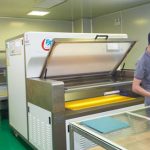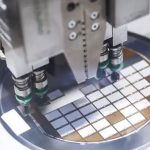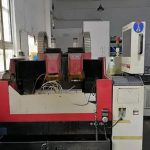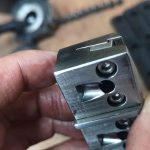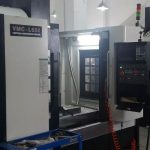
Heat dissipation is a major factor affecting the lighting intensity of LED lamps. The heat sink can solve the heat dissipation problem of low illumination LED lamps. A heat sink cannot solve the heat dissipation problem of 75W or 100W LED lamps.
In order to achieve the desired lighting intensity, active cooling technology must be used to address the heat released by the LED lighting components. Some active cooling solutions such as fans do not have as long a life as LED fixtures. In order to provide a practical active cooling solution for high-brightness LED lamps, the heat dissipation technology must be low energy consumption; be suitable for small lamps; and have a lifespan similar to or longer than the light source.
Heat dissipation method
Generally speaking, according to the way heat is taken away from the heatsink, the die casting heatsink can be divided into active cooling and passive cooling. The so-called passive heat dissipation means that the heat of the heat source LED light source is naturally dissipated into the air through the heat sink. The heat dissipation effect is proportional to the size of the heat sink. However, because it naturally dissipates heat, the effect is of course greatly reduced. It is often used in those spaces where In equipment without requirements, or used to dissipate heat for components that do not generate much heat. For example, some popular motherboards also use passive heat dissipation on the north bridge, and most use active heat dissipation. Active heat dissipation is forced through fans and other heat dissipation devices. It can effectively take away the heat emitted by the heat sink. It is characterized by high heat dissipation efficiency and small equipment size.
Active cooling, subdivided in terms of heat dissipation methods, can be divided into air-cooled heat dissipation, liquid cooling heat dissipation, heat pipe heat dissipation, semiconductor refrigeration, chemical refrigeration, etc.
Air-cooling is the most common way of heat dissipation, and it is also a cheaper way in comparison. Air cooling essentially uses a fan to take away the heat absorbed by the heatsink. It has the advantages of relatively low price and easy installation. However, it has a high dependence on the environment. For example, its heat dissipation performance will be greatly affected when the temperature rises and when overclocking.
Liquid Cooling
Liquid-cooling heat dissipation is a forced circulation of liquid driven by a pump to take away the heat from the heatsink. Compared with air cooling, it has the advantages of being quiet, stable cooling, and less dependent on the environment. The price of liquid cooling is relatively high, and installation is relatively troublesome. At the same time, when installing, try to follow the instructions in the instruction manual to obtain the best heat dissipation effect. Due to cost and ease of use considerations, liquid cooling usually uses water as the heat transfer liquid, so liquid cooling heatsinks are often called water cooling heatsinks.
Heat Pipe
The heat pipe is a heat transfer element that makes full use of the principle of heat conduction and the rapid heat transfer properties of the refrigerant medium. It transfers heat through the evaporation and condensation of liquid in a fully enclosed vacuum tube. It has extremely high thermal conductivity and good isothermal properties. The heat transfer area on both sides of the hot and cold sides can be changed arbitrarily, the heat can be transferred over long distances, and the temperature can be controlled. The heat exchanger composed of heat pipes has high heat transfer efficiency, compact structure, and low fluid resistance loss. advantage. Its thermal conductivity far exceeds that of any known metal.
1. Efficiency
The main feature of the heat pipe radiator is its efficient heat dissipation capacity. A heat pipe is a device that uses the principle of phase change heat transfer to transfer heat. It can quickly transfer heat from one end to the other. Compared with traditional heat dissipation methods, heat pipe radiators have faster heat transfer speed and higher heat dissipation efficiency. This means that using a heat pipe radiator can effectively reduce the temperature of the device and extend its service life.
2. Stability
Another advantage of heat pipe radiators is their stable heat dissipation performance. Since there are no moving parts inside the heat pipe, it is highly reliable and free from mechanical failure. At the same time, due to the characteristics of the heat pipe itself, its heat dissipation effect will not change due to changes in ambient temperature, and it has good robustness. This stability allows the heat pipe radiator to maintain good performance in various working environments.
3. Environmental protection
Heat pipe radiator is an environmentally friendly cooling solution. First of all, heat pipe radiators use natural cooling, which can reduce noise pollution compared to traditional fan radiators. Secondly, less materials are used in the manufacturing process of heat pipe radiators, which has less impact on the environment. In addition, due to the long service life of the heat pipe radiator, it can reduce the generation of electronic waste and help environmental protection.
4. Strong adaptability
Heat pipe radiators are designed to be flexible and can adapt to applications of various shapes and sizes. Whether it’s general computer hardware or specific industrial equipment, heat pipe radiators can be customized to suit your needs. At the same time, the installation and maintenance of heat pipe radiators are also very convenient and can meet various user needs.
5. Durable
The durability of heat pipes is particularly good, and their lifespan generally exceeds the life cycle of the equipment. This is because during the working process, the liquid inside the heat pipe will continuously circulate, and impurities in the liquid will be accumulated at the bottom of the heat pipe, preventing internal blockage. In addition, the surface of the heat pipe will not oxidize or corrode, reducing the possibility of failure. Therefore, using heat pipe radiators can greatly extend the service life of your equipment.
6. Silent performance
Heat pipe radiators usually adopt a fanless design, so they have better silent performance than traditional fan radiators. For application scenarios that require long-term operation, such as data centers, servers, etc., this silent performance can greatly reduce the noise level of the equipment and improve work efficiency and comfort.
7. High cost performance
Although the initial purchase cost of a heat pipe radiator may be slightly higher than that of a traditional radiator, its high efficiency and stability make it a cost-effective cooling solution in the long run. Due to their low energy consumption and low maintenance costs, heat pipe radiators tend to have a lower total cost of ownership than traditional radiators.
In summary, the heat pipe radiator has the characteristics and advantages of high efficiency, stability, environmental protection, adaptability, durability, silent performance and high cost performance, and is an excellent cooling solution. Whether it is a personal computer or industrial equipment, choosing a heat pipe radiator is a wise choice. With the continuous advancement of technology and the expansion of application fields, the prospects of heat pipe radiators will be broader. Let us welcome a new era of more efficient, stable and environmentally friendly cooling together!
Semiconductor Refrigeration
Semiconductor refrigeration uses a special semiconductor refrigeration chip to generate a temperature difference when energized. As long as the heat at the high-temperature end can be effectively dissipated, the low-temperature end will be continuously cooled. A temperature difference is generated on each semiconductor particle. A cooling chip is composed of dozens of such particles connected in series, thereby forming a temperature difference on the two surfaces of the cooling chip. Utilizing this temperature difference phenomenon and using air cooling/water cooling to cool down the high-temperature end can achieve excellent heat dissipation effects. Semiconductor refrigeration has the advantages of low cooling temperature and high reliability. The cold surface temperature can reach below minus 10, but the cost is too high, and it may cause short circuit due to too low temperature. Moreover, the current semiconductor refrigeration chip technology is not mature enough and is not practical enough. .
Chemical Refrigeration
The so-called chemical refrigeration is to use some ultra-low temperature chemicals to absorb a large amount of heat when melting to reduce the temperature. In this regard, the use of dry ice and liquid nitrogen is more common. For example, dry ice can be used to reduce the temperature to below minus 20, and some more ‘perverted’ players use liquid nitrogen to reduce the CPU temperature to below minus 100 (theoretically). Of course, due to its high price and short duration, this method has many Found in the lab or by extreme overclocking enthusiasts.
Material Selection
- Thermal conductivity coefficient (unit: W/mK)
- Silver 429
- Copper 401
- Gold 317
- Aluminum 237
- Iron 80
- Lead 34.8
- Type 1070 aluminum alloy 226
- Type 1050 aluminum alloy 209
- 6063 type aluminum alloy 201
- 6061 type aluminum alloy 155
Generally speaking, ordinary air-cooled heatsink naturally choose metal as the material of the radiator. For the selected material, it is hoped that it has both high specific heat and high thermal conductivity. From the above, it can be seen that silver and copper are the best thermal conductive materials, followed by gold and aluminum. But gold and silver are too expensive, so currently heat sinks are mainly made of aluminum and copper. In comparison, both copper and aluminum alloys have their own advantages and disadvantages: copper has good thermal conductivity, but it is more expensive, difficult to process, too heavy, and heatsinks have a small heat capacity and are easy to oxidize. . On the other hand, pure aluminum is too soft to be used directly. Only the aluminum alloy used can provide sufficient hardness. The advantages of aluminum alloy are low price and light weight, but the thermal conductivity is much worse than that of copper. Therefore, in the development history of radiators, products made of the following materials have also appeared:
Pure Aluminum Heatsink
Pure aluminum heatsink is the most common heatsink in the early days. Its manufacturing process is simple and low cost. So far, pure aluminum heatsink still occupies a considerable part of the market. In order to increase the heat dissipation area of its fins, the most commonly used processing method for pure aluminum radiators is aluminum extrusion technology, and the main indicators for evaluating a pure aluminum radiator are the thickness of the radiator base and the Pin-Fin ratio. Pin refers to the height of the fins of the heat sink, and Fin refers to the distance between two adjacent fins. The Pin-Fin ratio is the height of the Pin (excluding the thickness of the base) divided by the Fin. The larger the Pin-Fin ratio means the larger the effective heat dissipation area of the radiator, which means the more advanced the aluminum extrusion technology.
LED Heat Dissipation Technology
Pure copper heatsink
The thermal conductivity of copper is 1.69 times that of aluminum, so under the same conditions, a pure copper heatsink can take away heat from the heat source faster. However, the quality of copper is a problem. Many radiators advertised as “pure copper heatsinks” are not actually 100% copper. In the list of copper, those with a copper content of more than 99% are called acid-free copper, and the next grade of copper is red copper with a copper content of less than 85%. Most pure copper heatsinks currently on the market have a copper content somewhere in between. Some inferior pure copper heatsink contain less than 85% copper. Although the cost is very low, their heat conductivity is greatly reduced, affecting heat dissipation. In addition, copper also has obvious shortcomings, such as high cost, difficulty in copper machining, and large heatsink mass, which hinder the application of all-copper heat sinks. The hardness of red copper is not as good as that of aluminum alloy AL6063, and certain mechanical processing (such as trenching, etc.) performance is not as good as aluminum; the melting point of copper is much higher than that of aluminum, which is not conducive to extrusion (Extrusion) and other issues.
Copper-aluminum bonding technology
After considering the respective shortcomings of copper and aluminum, some high-end heatsink currently on the market often use a copper-aluminum combination manufacturing process. These heat sinks usually use copper metal bases, while the heat dissipation fins use aluminum alloy. Of course, In addition to the copper bottom, there are also methods such as using copper pillars for heat sinks, which are based on the same principle. With a high thermal conductivity, the copper bottom surface can quickly absorb the heat released by the CPU; the aluminum fins can be made into the most conducive shape for heat dissipation with the help of complex process means, and provide a large heat storage space and rapid release, which A balance point has been found in all aspects.
To improve the luminous efficiency and service life of LEDs, solving the heat dissipation problem of LED products is one of the most important issues at this stage. The LED industry has extremely strict requirements for the line alignment accuracy of the heat dissipation substrate itself, and it needs to have high heat dissipation and small size. Due to its size and good adhesion to metal circuits, the use of yellow light lithography to produce thin-film ceramic heat dissipation substrates will become one of the important catalysts to promote the continuous improvement of LEDs to high power.
Link to this article:LED Cooling Technology And Copper Tube Heatsink
Reprint Statement: If there are no special instructions, all articles on this site are original. Please indicate the source for reprinting:Alloy Wiki,thanks!^^



